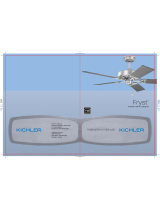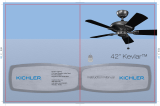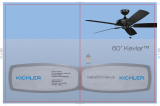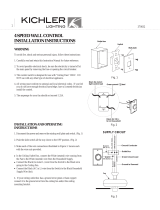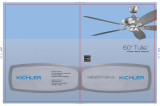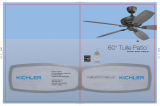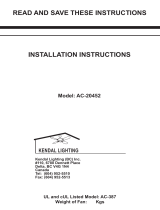Page is loading ...

2*
2*
Kichler
®
Lighting
7711 East Pleasant Valley Road
P.O. Box 318010
Cleveland, Ohio 44131-8010
Customer Service
866.558.5706
8:30 AM to 5:00 PM EST,
Monday - Friday
Instruction Manual
52” Lacey™LED
6 Speed DC Wall Control System
HIGH
EFFICIENCY
DC
MOTOR

Special Notice
This appliance is equipped with a "Wattage
Limiting Device" required by the United
States Department of Energy. The device
has been installed at the factory and can
not be removed.
Installing Lamps in excess of 75 total watts
will disable the unit's light fixture. If this
should happen, you will need to reset the
lighting fixture by turning the power off to
the ceiling fan and/or light fixture,
reinstalling lamps totaling less that 75 watts
and then turning the power back on.
1
1. SAFETY RULES
1. To reduce the risk of electric shock, insure
electricity has been turned off at the circuit
breaker or fuse box before beginning.
2. All wiring must be in accordance with the
National Electrical Code and local
electrical codes. Electrical installation
should be performed by a qualified
licensed electrician.
3. WARNING: Not suitable for use with
solid-state speed controls.
4. WARNING: To reduce the risk of fire,
electric shock, or personal injury, mount to
outlet box marked "acceptable for fan
support of 15.8 kg (35 lbs.) or less" and
use mounting screws provided with the
outlet box. Most outlet boxes commonly
used for the support of light fixtures are
not acceptable for fan support and may
need to be replaced. Due to the
complexity of the installation of this fan, a
qualified licensed electrician is strongly
recommended.
5. The outlet box and support structure must
be securely mounted and capable of
reliably supporting a minimum of 50
pounds. Use only CUL Listed outlet boxes
marked "FOR FAN SUPPORT".
6. The fan must be mounted with a minimum
of 7 feet clearance from the trailing edge of
the blades to the floor.
7. To operate the reverse function on this fan,
press the reverse button while the fan is
running.
8. Avoid placing objects in the path of the
blades.
WARNING
TO REDUCE THE RISK OF FIRE, ELECTRIC
SHOCK OR PERSONAL INJURY, MOUNT
FAN TO OUTLET BOX MARKED
"ACCEPTABLE FOR FAN SUPPORT".
9. To avoid personal injury or damage to the
fan and other items, be cautious when
working around or cleaning the fan.
10. Do not use water or detergents when
cleaning the fan or fan blades. A dry dust
cloth or lightly dampened cloth will be
suitable for most cleaning.
11. After marking electrical connections,
spliced conductors should be turned
upward and pushed carefully up into
outlet box. The wires should be spread
apart with the grounded conductor and
the equipment-grounding conductor on
one side of the outlet box.
12. Electrical diagrams are reference only.
Light kits that are not packed with the fan
must be CUL Listed and marked suitable
for use with the model fan you are
installing. Switches must be CUL General
Use Switches. Refer to the Instructions
packaged with the light kits and switches
for proper assembly.
WARNING
TO REDUCE THE RISK OF PERSONAL
INJURY, DO NOT BEND THE BLADE
BRACKETS (ALSO REFERRED TO AS
FLANGES) DURING ASSEMBLY OR AFTER
INSTALLATION. DO NOT INSERT
OBJECTS IN THE PATH OF THE BLADES.

2
3. PACKAGE CONTENTS
Unpack your fan and check the contents. You
should have the following items:
a. Fan blades (5)
b. Canopy & Ceiling mounting bracket
c. Ball/downrod assembly
d. Fan motor assembly
e. Set of 5 blade brackets
f. Light plate
g. 17W LED light kit
h. Glass shade
i. Wall Transmitter
j. Allen wrench
k. Part bag contents
1) Mounting hardware:
star washers (2), wire nuts (3),
machine screws (2), washers (2),
screws (2)
2) Blade attachment hardware:
screws (17), fiber washers (17)
3) Blade bracket attachment hardware:
screws (12)
4) Safety cable hardware:
wood screw, lock washer, flat washer
5) Balance Kit
Philips screw driver
Blade screw driver
11 mm wrench
Step ladder
Wire cutters
2. TOOLS AND MATERIALS REQUIRED
i
k
j
f
g
h
a
b
c
d
e
52" Lacey
TM
LED

3
4. MOUNTING OPTIONS
If there isn't an existing UL (cUL for Canadian
Installation) listed mounting box, then read the
following instructions. Disconnect the power
by removing fuses or turning off circuit
breakers.
Secure the outlet box directly to the building
structure. Use appropriate fasteners and
building materials. The outlet box and its
support must be able to fully support the
moving weight of the fan (at least 50 lbs). Do
not use plastic outlet boxes.
Figures 1, 2 and 3 are examples of different
ways to mount the outlet box.
NOTE: If you are installing the ceiling fan on a
sloped (vaulted) ceiling, you may need a
longer downrod to maintain proper clearance
between the tip of the blade and the ceiling. A
minimum clearance of 12" is suggested for
optimal operation.
NOTE: Depending on the location you have
selected for installation, you may need to
purchase and install a "Joist Hanger" for the
support of the outlet box. Make sure the joist
hanger you purchase has been designed for
use with ceiling fans. (Fig. 4)
Outlet box
Provide strong
support
Recessed
outlet box
Ceiling
mounting
plate
Outlet box
Fig. 1
Fig. 3
Fig. 4
Outlet box
Fig. 2
ANGLED CEILING
MAXIMUM 20
°
ANGLE

4
Fig. 8
Fig. 7
Mounting screws
(supplied with
electrical box)
Hook
Ceiling
mounting
bracket
ETL Listed
outlet box
120V Wires
Washers
Ceiling mounting
bracket
Canopy
Canopy cover
Fig. 6
Fig. 5
5. HANGING THE FAN
RMEMEBER to turn off the power before you
begin installation. This is necessary for your
safety and also the proper programing of the
control system.
To properly install your ceiling fan, follow the
steps below.
Step 1. Remove the decorative canopy
bottom cover from the canopy by turning the
cover counter clockwise. (Fig. 5)
Step 2. Remove the ceiling mounting bracket
from the canopy by removing (and save) one
of the two screws. Loosen the remaining
screw by a half turn. (Fig. 5)
Step 3. Pass the 120 volt supply wires from
the ceiling outlet box through the center of the
ceiling mounting bracket. (Fig. 6)
Step 4. Attach the ceiling mounting bracket to
the outlet box using the screws and washers
included with the outlet box. (Fig. 6)
Step 5. Remove the coupling cover from the
motor housing by removing the screws from
the rim of coupling cover. (Fig. 7)
Step 6. Remove the hanger ball from the
downrod assembly by loosening the set
screw, removing the cross pin and sliding the
ball off the rod. (Fig. 8)
SPECIAL NOTE: For proper Control System
Programing, it is essential that power is NOT
connected or turned on to the ceiling fan
during the installation process.
You will be instructed at the proper time to
power up the system.
Collar
Coupling cover
Motor housing
Screws
Cross pin
Hanger ball
Set screw
Downrod
52" Lacey
TM
LED

5
Fig. 9
Fig. 11
Fig. 10
Registration slot
Check tab
Step 7. Loosen the two set screws and
remove the hitch pin and retaining clip from
the coupling on top of the motor assembly.
(Fig. 9)
Step 8. Carefully feed the electrical lead wires
from the fan up through the downrod. Thread
the downrod into the coupling until the Hitch
pin holes are aligned.
Next, replace the hitch pin and retaining clip.
Tighten both set screws. (Fig. 9)
Step 9. Slip the coupling cover, canopy cover
and canopy onto the downrod. Secure the
coupling cover to the motor housing using the
screws previously removed. (Fig. 10)
Thread the hanger ball onto the downrod,
insert the cross pin through the downrod and
tighten. Now tighten the set screw. (Fig. 10)
Step 10. Lift the motor assembly into position
and place the hanger ball into the ceiling
mounting bracket.
Rotate the entire assembly until the "Check
Tab" has dropped into the "Registration Slot"
and seats firmly. (Fig. 11)
The entire motor assembly should not rotate
(left or right) when seated properly.
WARNING: Failure to reattach the cross pin
and seat the "Check Tab" can cause the fan
to fall from the ceiling during operation. Take
special care to make sure this pin is
reattached.
Downrod
Canopy
Canopy cover
Coupling cover
Screws
Cross pin
Hanger ball
Set screw
Supply wires
Downrod
Hitch pin
Retaining clip
Set screws
Coupling
Motor housing

Fig. 12
6. INSTALLATION OF SAFETY SUPPORT
(required for Canadian installation ONLY)
A safety support cable is provided to help
prevent the ceiling fan from falling.
Step 1. Attach the provided wood screw and
washers to the ceiling joist next to the
mounting bracket but do not tighten. (Fig. 12)
Step 2. Adjust the length of the safety cable to
reach the screw and washers by pulling the
extra cable through the cable clamp until the
overall length is correct, put the end of the
cable back through the cable clamp, forming a
loop at the end of the cable. Tighten the cable
clamp securely. Now, put the loop in the end of
the safety cable over the wood screw and
under the washer. Tighten the wood screw
securely.
NOTE: Although the safety support cable is
required for Canadian installations only. It's a
good idea to make the attachment with any
installation.
Ceiling mounting
bracket
Attach
safety cable
to ceiling joist
with screw and
washer
6
52" Lacey
TM
LED

7
Fig. 13
SUPPLY CIRCUIT
BLACK
BLACK
BLACK BLACK
Ground Conductor
Outlet Box
Green Ground Lead
Ground to Downrod
GREEN
WHITE
WHITE
Fan
RECEIVER
7. ELECTRICAL CONNECTIONS
WARNING: Carefully read and retain this
Instruction Manual for future reference.
WARNING:To avoid possible electrical shock,
be sure the electricity is turned off at the main
panel by removing the fuse or opening the
circuit breaker.
WARNING:This control switch is designed for
use with "DC Motor Ceiling Fans" ONLY. DO
NOT use with any other type of electrical
appliance.
WARNING:All wiring must conform to national
and local electrical codes. If you feel you do not
have enough electrical knowledge, have a
licensed electrician install the control.
WARNING:The amperage for your fan should
not exceed 1A. The total wattage for the lights
300W.
Make each of the wire connections illustrated
in Figure 3. Secure each with the wire nuts
provided. (Fig. 13)
Step 1. Black wire going to the fan (motor) to
the Black wire from the Switch. (Fig. 13)
Step 2. In the Ceiling Outlet Box, connect the
White (neutral) wire coming from the Fan to
the White (neutral) wire from the Household
Supply. (Fig. 13)
Step 3. Connect the Black (AC IN L) from the
switch to the Black wire going to the
Household Supply. (Fig. 13)
Step 4. If your ceiling outlet box has a ground
wire (green or bare copper) connect it to the
ground wire from the ceiling fan and/or the
ceiling mounting bracket. (Fig. 13)

8
Fig. 14
Outlet box
Ceiling
mounting
bracket
Canopy
Canopy cover
Screws
Screws
8. FINISHING THE INSTALLATION
Step 1. Tuck all the connections neatly into the
ceiling outlet box.
Step 2. Slide the canopy up to the mounting
bracket and place one of the key hole slots over
the mounting screw on the mounting bracket.
Rotate the canopy until the screw head locks in
place at the narrow section of the key hole.
See figure 14.
Step 3. Align the remaining circular hole on the
canopy with the remaining hole on the Ceiling
Mounting Bracket. Insert and tighten the
mounting screw you removed earlier and the
mounting screw from Step 2 above. Now,
attach the canopy cover to the mounting screw
heads by inserting the screw heads into the
bottom side of the canopy cover and rotating
the cover clockwise.
NOTE: Adjust the canopy screws as necessary
until the canopy and canopy cover are snug.
(Fig. 14)
Warning: Make sure the "Check Tab" at the
bottom of the hanger bracket is properly seated
in the "Registration Slot" on the side of the
hanger ball before attaching the canopy to the
bracket. Failure to properly seat the "Check
Tab" could damage the electrical wires when to
ceiling fan blade direction is changed while the
fan is running.
52" Lacey
TM
LED

9
10. INSTALLING THE LIGHT PLATE
Step 1. Loosen the two screws on the
mounting ring attached to the motor shaft and
"remove" and save the third screw. (Fig. 16)
Step 2. Place the key hole slots on the light
plate over the two screws previously loosened
on the mounting ring.
Turn the light plate until is locks in place at the
narrow section of the key hole slots.
Tighten both key hole screws and replace the
third screw previously removed and tighten
securely.
Fig. 15
Fig. 16
Mounting ring
Screws
Light plate
9. ATTACHING THE FAN BLADES
Step 1. Attach a blade to a blade bracket
using the screws and fiber washers provided.
(Fig. 15)
Make sure the blade is straight when set on
the blade bracket. Tighten each mounting
screw and then repeat this procedure for each
blade.
Step 2. Attach each blade assembly to the
motor using the screws and Allen wranch
provided. (Fig 15)
Screws
Blades
Blade brackets
Screws
Fiber
washers
Allen wrench

10
11. INSTALLING THE LED LIGHT KIT
AND GLASS SHADE
NOTE: Before starting installation, disconnect
the power by turning off the circuit breaker or
removing the fuse at fuse box.
Step 1. Loosen the three mounting screws on
the inside of the LED light kit. (Fig.17)
Step 2. While holding the LED light kit under
the fan motor, make the wire connections:
(Fig. 17)
- Red to white
- Black to black
Step 3. Tuck the connections neatly into the
light plate. Place the key holes on the LED
light kit over the 2 screws previously loosened
from the light plate, turn the LED light kit until
it locks in place at the narrow section of the
key holes. Secure by tightening all three
screws. (Fig.17)
Step 4. Remove the decorative nut, glass cap
and metal nut from the LED light kit. Place
glass shade over the LED light kit stem,
secure with the metal nut (rubber side on the
top), glass cap and decorative nut. Do not
overtighten. (Fig.17)
Step 5. Restore power and your light kit is
ready for operation. (Fig. 17)
Fig. 17
Screws
Light plate
Wire connectors
LED light kit
Glass shade
Decorative nut
Glass cap
Metal nut
52" Lacey
TM
LED

11
Fig. 18
12. CONTROL SYSTEM SET-UP
Press the power button on wall control to
TURN THE POWER ON.The LED lights on the
wall control will blink thru the power up
process, approximately 3 seconds.
Within 60 seconds of powering the unit on,
Press and hold the REV/FOR button on the
wall control until the light kit blinks twice (or
for 5 seconds if no light kit). Fan will begin
operating on high speed.
DO NOT TOUCH ANY ADDITIONAL
BUTTONS FOR 5 MINUTES. The fan control
is performing the setup process necessary for
the wall control to communicate with the fan.
In approximately 5 minutes the ceiling fan will
shut off. This is your indication that the
programming process is complete and your
ceiling fan is ready for normal use.
NOTE: To purge unwanted frequency codes
in a fan receiver:
From the desired control, turn the power on to
the fan.
Within 60 seconds of powering the unit on,
press the REV/FOR button for 10 seconds.
This purges all codes in the fan receiver
leaving only one code from the control used
for this step.
DO NOT TOUCH ANY ADDITIONAL
BUTTONS FOR 5 MINUTES. The fan control
is performing the setup process necessary for
the wall control to communicate with the fan.
In approximately 5 minutes the ceiling fan will
shut off. This is your indication that the
programming process is complete and your
ceiling fan is ready for normal use.
Green Light
For/Rev switch
Light status indicator
Fan speed indicator
Power switch

12
Fig. 19
13. BUTTON INSTRUCTION
LED Indicator Red LED: Transmitter signal
indicator. When RF signal is sending, the red
light will illuminate.
Green LED: To show the Forward and
Reverse indicator.
ON/OFF button " "
ON: Turn on the power.
OFF: Turn off the power.
Reverse button " "
When the fan is running, press and release the
Reverse button one time, the fan will change
operating direction.
Downflow: Green indicator LED will be off.
Reverse: Green indicator LED will be on.
Light button " "
Press and release the Light button for light
ON/OFF control.
Light indicator LEDs will show current light
status. If the light kit is OFF, the Light
indicator LEDs are also all off. Press AND
HOLD the light button for more than 1 second
and the light kit will begin dimming. Light
indicator LED will show the change in light
level status. The light level cycles from bright
to dim and back to bright when the light
button is held.
Fan control " "
Press and release the Fan speed button for
Fan ON/OFF control.
Fan indicator LED will illustrate the current fan
speed. If the fan is OFF, the fan speed
indicator LEDs will also be OFF. Press and
hold Fans speed button for more than
1second to begin adjusting the fan speeds.
The indicator LEDs will shows the current
speed level. The fan speed adjustments adjust
in a repeat cycle when the speed button is
held down. The speeds adjust from High to
Low, then back up to High.
52" Lacey
TM
LED

13
14. INSTALLING THE WALL CONTROL
SYSTEM WALL PLATE
Select a location to install the Wall Control
System Transmitter and Wall Plate.
REMEMBER also this should state that the
control is not to be mounted outdoors. You
can safely use the transmitter outdoors but it
should be mounted indoors away from excess
heat and away from contact with water or
humidity.
Install the wall plate using an existing wall
switch outlet box. Make sure the electrical
power is TURNED OFF at the main panel
before continuing.
Step 1. Remove the existing wall plate and the
old switch from the wall outlet box. Wire nut
the BLACK leads (hot) together and push
back inside the outlet box. (Fig. 20)
Step 2. Install the wall plate on the existing
wall outlet box using the screws provided.
(Fig. 21)
After installing the wall anchors, attached the
wall plate with the mounting screws to finish
the installation.
Fig. 21
Fig. 20
Wall plate
Switch
Outlet box
Screws
Outlet box
Screws
Wall plate
Switch

14
Fig. 22
Fig. 23
15. OPERATING INSTRUCTIONS
Warm weather - Forward (counter clockwise)
A downward airflow creates a cooling effect
as shown in Fig. 22. This allows you to set
your air conditioner on a warmer setting
without affecting your comfort.
Cool weather - Reverse (clockwise) An
upward airflow moves warm air off the ceiling
area as shown in Fig. 23. This allows you to
set your heating unit on a cooler setting
without affecting your comfort.
NOTE: To change the airflow direction of your
ceiling fan use the FOR/REV button on the
wall control transmitter.
52" Lacey
TM
LED

15
Problem
Fan will not start.
Fan sounds noisy.
Fan wobble.
Remote control
malfunction.
Solution
1. Check circuit fuses or breakers.
2. Check all electrical connections to insure proper contact. CAUTION: Make
sure the main power is OFF when checking any electrical connection.
1. Make sure all motor housing screws are snug.
2. Make sure the screws that attach the fan blade brackets to the motor are
tight.
3. Make sure wire nut connections are not rubbing against each other or the
interior wall of the switch housing. CAUTION: Make sure main power is off.
4. Allow a 24-hour "breaking-in" period. Most noise associated with a new fan
disappear during this time.
5. If using an optional light kit, make sure the screws securing the glassware are
tight. Make sure the light bulbs are not touching any other component.
6. Do not connect this fan to wall mounted variable speed control(s). they are
not compatible with ceiling fan motors or remote controls.
7. Make sure the upper canopy is a short distance from the ceiling. It should not
touch the ceiling.
1. Check that all blade and blade arm screws are secure.
2. Most fan wobbling problems are caused when blade levels are unequal.
Check this level by selecting a point on the ceiling above the tip of one of the
blades. Measure this distance. Rotate the fan until the next blade is positioned
for measurement. Repeat for each blade. The distance deviation should be
equal within 1/8".
3. If the blade wobble is still noticeable, interchanging two adjacent (side by
side) blades can redistribute the weight and possibly result in smoother
operation.
1. Ceiling Fans with remote control systems CAN NOT be operated in
conjunction with any other control system EXCEPT a basic On/Off wall switch,
if desired.
16. TROUBLESHOOTING
17. SPECIFICATIONS
These are approximate measurements. They do not include data for any lamps or fixtures
attached to the ceiling fan.
11
kgs
N.W.
12
kgs
G.W.
2.29'
C.F.RPM
170
149
124
101
85
49
CFM
5891.00
5128.00
4307.00
3565.00
3105.00
1934.00
CFM/W
186
264
353
446
526
624
Fan Size
52"
120
120
120
120
120
120
Volts
0.39
0.26
0.17
0.12
0.09
0.05
Amps
31.70
19.40
12.20
8.00
5.90
3.10
WattsSpeed
Extra-High
High
Medium High
Medium
Medium Low
Low
/

